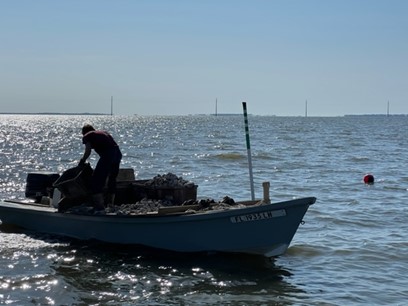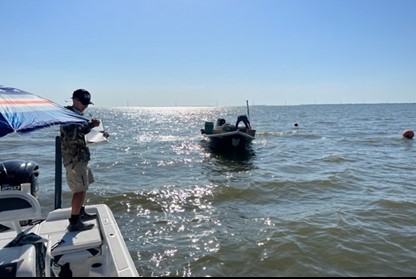 In early May, the Apalachicola Bay System Initiative (ABSI) completed its second round of oyster reef restoration experiments. With the help of almost 20 local oystermen and women, they were able to effectively deploy 416 cubic yards of limerock, 416 cubic yards of concrete, and 96 cubic yards of shell into the Cat Point area of Apalachicola.
In early May, the Apalachicola Bay System Initiative (ABSI) completed its second round of oyster reef restoration experiments. With the help of almost 20 local oystermen and women, they were able to effectively deploy 416 cubic yards of limerock, 416 cubic yards of concrete, and 96 cubic yards of shell into the Cat Point area of Apalachicola.
These materials were strategically deployed between 16 sites (50 ft x 26 ft) along the Cat Point region, approximately 2,000 feet southeast from the nearest shoreline. The 16 sites were further broken down into 4 areas with 4 distinct treatment types. Treatments were comprised of the following:
1. 2-6” limerock deployed 15” high
2. 2-6” limerock deployed 12” high with 3” of cured shell deployed on top
3. 4-6” concrete deployed 15” high
4. 4-6” concrete deployed 12” high with 3” of cured shell deployed on top.
 The deployment will help to further clarify how substrate type (limerock, concrete, and shell) potentially affects oyster growth rates and mortality, spat settlement, predator presence, and overall oyster health. ABSI aims to continuously monitor these 16 sites over the next 2 years.
The deployment will help to further clarify how substrate type (limerock, concrete, and shell) potentially affects oyster growth rates and mortality, spat settlement, predator presence, and overall oyster health. ABSI aims to continuously monitor these 16 sites over the next 2 years.
A deployment of this scale would not have been successfully completed in only five days if it was not for the support and collaboration of local oystermen and women. ABSI is excited to monitor the sites and is looking forward to sharing their results with the public in due time!

